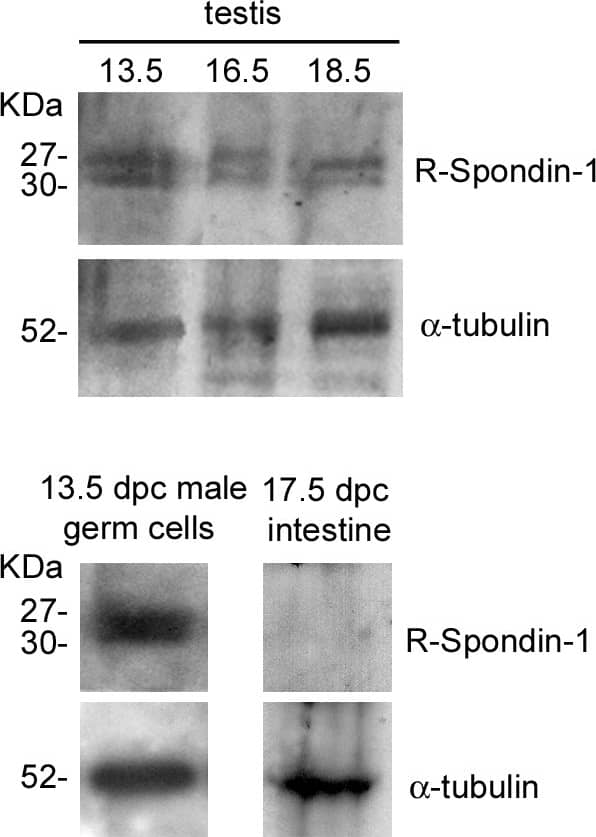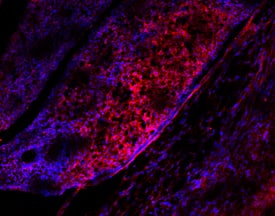Mouse R-Spondin 1 Antibody
R&D Systems, part of Bio-Techne | Catalog # AF3474

Key Product Details
Species Reactivity
Validated:
Cited:
Applications
Validated:
Cited:
Label
Antibody Source
Product Specifications
Immunogen
Ser21-Gly209
Accession # Q9Z132
Specificity
Clonality
Host
Isotype
Scientific Data Images for Mouse R-Spondin 1 Antibody
R‑Spondin 1 in Mouse Ovary.
R-Spondin 1 was detected in immersion fixed frozen sections of E13.5 mouse ovary using Goat Anti-Mouse R-Spondin 1 Antigen Affinity-purified Polyclonal Antibody (Catalog # AF3474) at 10 µg/mL overnight at 4 °C. Tissue was stained using the NorthernLights™ 557-conjugated Anti-Goat IgG Secondary Antibody (red; Catalog # NL001) and counterstained with DAPI (blue). View our protocol for Fluorescent IHC Staining of Frozen Tissue Sections.Detection of Mouse R-Spondin 1 by Western Blot
RSPO1 protein content and distribution pattern during male gonad development.Left panel: (Upper part) Western blot analysis of RSPO1 in 13.5, 16.5 and 18.5 dpc embryonic male gonads, and 13.5 dpc male germ cells. As RSPO1 western blot negative control 17.5 dpc intestine is also reported. Two different bands, corresponding to the immature (27 KDa band) and the glycosilated isoform (30 KDa band), were detected. (Lower part) Confocal microscopy analysis of RSPO1 distribution observed by whole mount immunofluorescence (FITC signal) in 15.5 dpc ovary (positive control) and in 13.5 dpc male germ cells. RSPO1 immuno-labeled germ cells were double stained with anti-VASA (germ cell marker) antibody. Right panel: Confocal microscopy analysis of RSPO1 distribution observed by whole mount immunofluorescence (FITC signal) in 11.5 (A), 12.5 (C and D), 13.5 (E and F), 16.5 (G and H), and 18.5 dpc (I and L) male UGRs at different magnifications. In B the corresponding bright field of 11.5 dpc male genital ridge is reported. ce: coelomic epithelium; gr: genital ridge; ms: mesonephros; tc: testicular cords; ts: testis, ov: ovary. Image collected and cropped by CiteAb from the following publication (https://dx.plos.org/10.1371/journal.pone.0124213), licensed under a CC-BY license. Not internally tested by R&D Systems.Applications for Mouse R-Spondin 1 Antibody
Immunohistochemistry
Sample: Immersion fixed frozen sections of mouse ovary (E13.5)
Western Blot
Sample: Recombinant Mouse R-Spondin 1 (Catalog # 3474-RS)
Formulation, Preparation, and Storage
Purification
Reconstitution
Formulation
Shipping
Stability & Storage
- 12 months from date of receipt, -20 to -70 °C as supplied.
- 1 month, 2 to 8 °C under sterile conditions after reconstitution.
- 6 months, -20 to -70 °C under sterile conditions after reconstitution.
Background: R-Spondin 1
R-Spondin 1 (RSPO1, Roof plate-specific Spondin 1), also known as cysteine-rich and single thrombospondin domain containing protein 3 (Cristin 3), is a 27 kDa secreted protein that belongs to the R-Spondin family (1, 2). R-Spondins share around 40% aa identity. All regulate Wnt/ beta-catenin signaling, but have distinct expression patterns (1 - 3). Like other R-spondins, R-Spondin 1 contains two adjacent cysteine-rich furin-like domains (amino acids (aa) 34 - 135) followed by a thrombospondin (TSP-1) motif (aa 147 - 207) and a region rich in basic residues (aa 211 - 263). Only the furin-like domains are needed for beta-catenin stabilization (2, 4). A putative nuclear localization signal at the C-terminus may allow some expression in the nucleus (5). R-Spondin 1 contains one potential N-glycosylation site. Over aa 21 - 209, mouse R-Spondin 1 shares 98%, 94%, 94%, 93%, 92% and 88% aa identity with rat, human, horse, cow, goat and dog RSPO-1, respectively. R-Spondin 1 is expressed in early development at the roof plate boundary and is thought to contribute to dorsal neural tube development (3, 5). In humans, rare disruptions of the R-Spondin 1 gene are associated with tendencies for XX sex reversal (phenotypic male) or hermaphroditism, indicating a role for R-Spondin 1 in gender-specific differentiation (6, 7). Disruption is also associated with palmoplantar keratosis (6, 7). Postnatally, R-Spondin 1 is expressed by neuroendocrine cells in the intestine, adrenal gland and pancreas, and by epithelia in kidney and prostate (8). Injection of recombinant R-Spondin 1 in mice causes activation of beta-catenin and proliferation of intestinal crypt epithelial cells, and ameliorates experimental colitis (8, 9). R-Spondin 1 appears to regulate Wnt/ beta-catenin by competing with the Wnt antagonist DKK-1 for binding to the Wnt co-receptor, Kremen (10). This competition reduces internalization of DKK-1/LRP-6/Kremen complexes (10). Reports differ on whether R‑Spondin 1 binds LRP-6 directly (10 - 12).
References
- Lowther, W. et al. (2005) J. Virol. 79:10093.
- Kim, K-A. et al. (2006) Cell Cycle 5:23.
- Nam, J-S. et al. (2007) Gene Expr. Patterns 7:306.
- Kazanskaya, O. et al. (2004) Dev. Cell 7:525.
- Kamata, T. et al. (2004) Biochim. Biophys. Acta 1676:51.
- Tomaselli, S. et al. (2008) Hum. Mutat. 29:220.
- Parma, P. et al. (2006) Nat. Genet. 38:1304.
- Kim, K-A. et al. (2005) Science 309:1256.
- Zhao, J. et al. (2007) Gastroenterology 132:1331.
- Binnerts, M.E. et al. (2007) Proc. Natl. Acad. Sci. USA 104:14700.
- Nam, J-S. et al. (2006) J. Biol. Chem. 281:13247.
- Wei, Q. et al. (2007) J. Biol. Chem. 282:15903.
Long Name
Alternate Names
Gene Symbol
UniProt
Additional R-Spondin 1 Products
Product Documents for Mouse R-Spondin 1 Antibody
Product Specific Notices for Mouse R-Spondin 1 Antibody
For research use only

